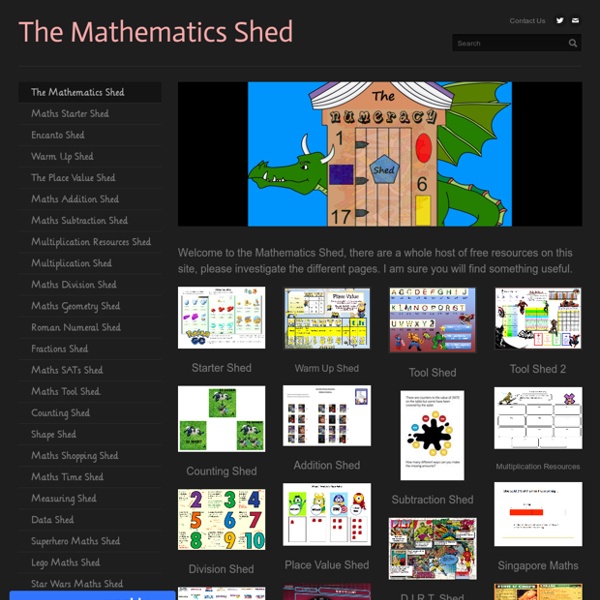



http://www.mathematicshed.com/
Related: Numeracy • maths • eadrelihan2School Techie: 5 Great Simple Machines Sites Number BalanceGrades: 1-3 Summary: Use the idea of the sea saw to balance the equation. Great way to show the students which side has a the greater sum. How to integrate: Shared, Modeled Make XGrades: 3-5Summary: Arrange the cards and arithmetic signs into a formula that makes X. You can use any of the operations to reach the goal. How do we make John Hattie’s “Visible Learning” work in maths? Visible Learning is John Hattie’s mantra. I’ve written previously about being a big fan of Hattie’s work about what affects achievement. He’s collected just about every piece of academic research and collated a ranked taxonomy of factors that affect achievement. Visible Learning is his suggested approach to teaching in a way that incorporates many of the significant drivers of achievement. He sums up what Visible Learning looks like using the analogy of teaching someone to abseil. The main features of the learning being:
Number Games for Kids Online - SplashLearn Frequently Asked Questions: Q1: How do I teach my kindergartener to recognize numbers? Ans: You can use objects, pictures, counters or abacus to make your kindergarten learn and recognise numbers. These objects can be kept in a group and child can identify how many are they using numbers. The Teacher Who Believes Math Equals Love : NPR Ed What makes a great teacher great? That's the question at the heart of 50 Great Teachers, from the NPR Ed Team. For her trigonometry class, Sarah Hagan (center) uses everything but the kitchen sink: a flower pot, garbage basket, rolls of tape, rubber balls, even loose spaghetti. Elissa Nadworny/NPR hide caption toggle caption Elissa Nadworny/NPR
Top rated maths activities - FlashMaths.co.uk Top rated maths activities Mean from Frequency Tables Compound Interest Calculator The Makings of First Class Maths So the level 6 tests were introduced into primary schools at the end of KS2, and I took a sharp intake of breath: was the maths curriculum about to become narrowed for our most able learners? I appreciated that there were many children for whom a greater level of challenge was required to retain an interest and purpose in maths. However, I feared that in reality our most able children would be accelerated through monotonous, dry level 6 materials (or, more to the point, past papers) in order for them to reach the level 6 holy grail. My belief, a view supported by all manner of research and guidance, was that more able children need to be given deep, conceptual mathematical experiences rather than to be accelerated through maths content.
Nature of Science Teaching Activities / Nature of science The Nature of Science strand is described in the science learning area as the overarching and unifying strand. How might this influence our teaching and our choice of teaching activities? What teaching activities will help us teach the nature of science? The teaching activities in this section provide examples for how we might adapt other activities to meet the aims of the Nature of Science strand. The Nature of Science strand has four achievement aims which are summarised as: Understanding about science, Investigating in science, Communicating in science, Participating and contributing.
Exploring Geometry by Coding With @gosphero & @tickleapp In this article I would like to dissect the Math curriculum here in Ontario and focus on the process of mathematics. From the Ontario curriculum document: Problem Solving Problem solving is central to learning mathematics. By learning to solve problems and by learning through problem solving, students are given numerous opportunities to connect mathematical ideas and to develop conceptual understanding.
Using & Applying < Maths Zone - Free Cool Learning Games for School Symbols & Formulae Problem solving Money Equivalence Independent Learning using iPods in Maths (iPodagogy) Since the beginning of September we have been trying to maximise the use of 1:1 iPods in year 6 in all areas of curriculum. The potential of enhancing teaching and learning in mathematics through the use of this technology has been particularly interesting. We have been developing the creative use of a range of Apps to support progress, engage children and add relevance to maths teaching with positive outcomes ( 10 Practical ways to use Apps in Maths ) We have also explored a wide range of maths specific Apps which have helped pupils mainly in the areas of number fact and tables recall. ( Apps for Maths ) Recently we have extended the use of the iPods to allow them to support independent learning, and play a central role in effective formative assessment.
The history of the European Union EU Pioneers The following visionary leaders inspired the creation of the European Union we live in today. Without their energy and motivation, we would not be living in the sphere of peace and stability that we take for granted. From resistance fighters to lawyers and parliamentarians, the EU pioneers were a diverse group of people who held the same ideals: a peaceful, united and prosperous Europe. Beyond the pioneers described below, many others have worked tirelessly towards and inspired the European project.